Stihl Brush Cutter FS 250 Tips for Thick Brush (5 Pro Hacks)
Did you know that improper brush clearing leads to over $1 billion in damages annually due to wildfires in the United States alone? This staggering figure underscores the importance of effective brush management. As someone who’s spent countless hours battling thick undergrowth and stubborn saplings, I understand the challenges firsthand. That’s why I’m excited to share my top five pro hacks for wielding the Stihl FS 250 brush cutter to conquer even the most formidable thick brush. These aren’t just tips I’ve read in a manual; they’re hard-earned lessons from the field, designed to boost your efficiency, safety, and overall success. Let’s dive in.
Stihl Brush Cutter FS 250 Tips for Thick Brush (5 Pro Hacks)
1. Mastering the Art of Blade Selection: Matching the Metal to the Mayhem
Choosing the right blade for your Stihl FS 250 is paramount. It’s not a one-size-fits-all situation. Think of it like selecting the right tool for any job – a screwdriver won’t cut it when you need a hammer. The same principle applies here. The type of vegetation you’re tackling will dictate the best blade for the job.
-
For Dense Grass and Weeds: A simple nylon line head or a two-bladed grass cutting blade will suffice. These are ideal for maintaining open areas and trimming around obstacles.
-
For Thicker Brush and Saplings (Up to 2 inches in diameter): This is where the real work begins. I recommend a brush knife with multiple teeth (e.g., an 8-tooth or 4-tooth blade). These blades are designed to slice through thicker stems with ease. They’re also less prone to kickback than some other options.
-
For Heavy-Duty Clearing (Saplings 2-4 inches in diameter): You’ll need a saw blade, often referred to as a “clearing saw blade.” These blades resemble miniature circular saw blades and are capable of cutting through substantial woody material. However, exercise extreme caution when using these, as kickback potential is high.
My Personal Experience: I once tried to clear a patch of blackberries with a simple grass blade. It was a disaster! The blade kept getting tangled, and I was making very slow progress. Switching to an 8-tooth brush knife made all the difference. It sliced through the thorny vines like butter, and I finished the job in a fraction of the time.
Data Point: Studies show that using the correct blade for the job can increase cutting efficiency by up to 40%. This translates to less time spent clearing brush and reduced wear and tear on your machine.
Actionable Takeaway: Before you start, take a moment to assess the type of brush you’ll be cutting. Choose the blade that is best suited for the job. Don’t be afraid to experiment to find what works best for you. Always consult your Stihl FS 250 owner’s manual for recommended blade types and safety guidelines.
2. Harnessing the Power: Proper Technique and Body Positioning
The Stihl FS 250 is a powerful machine, but its effectiveness depends heavily on your technique. Poor technique can lead to fatigue, inefficiency, and even injury. Here are some key points to keep in mind:
-
Stance and Balance: Maintain a wide, stable stance with your feet shoulder-width apart. This will give you a solid base of support and help you maintain control of the brush cutter. Distribute your weight evenly and avoid leaning too far forward or backward.
-
Swing Technique: Use a smooth, sweeping motion, pivoting from your hips and shoulders. Avoid using just your arms, as this will quickly lead to fatigue. Let the blade do the work; don’t force it.
-
Cutting Direction: Whenever possible, cut in a direction that allows the debris to fall away from you. This will prevent the brush from getting tangled around the blade and will also improve visibility.
-
Harness Adjustment: The harness is your friend. Adjust it properly so that the weight of the brush cutter is evenly distributed across your shoulders and back. This will significantly reduce strain and fatigue. The handle should be adjusted to comfortably and safely support the brush cutter.
My Personal Experience: I remember one time I was rushing to clear a large area and didn’t bother to adjust the harness properly. After just an hour, my back was killing me. I took a break, adjusted the harness, and the difference was night and day. I was able to work much longer and more efficiently.
Data Point: Studies have shown that proper body mechanics can reduce the risk of musculoskeletal injuries by up to 60% in manual labor tasks.
Actionable Takeaway: Before you start working, take a few minutes to adjust your harness and practice your swing technique. Focus on using your whole body to power the brush cutter, rather than just your arms. Remember to take frequent breaks to avoid fatigue.
3. Fueling the Beast: Optimizing Performance and Longevity
The Stihl FS 250, like any internal combustion engine, requires proper fuel and maintenance to perform optimally and last for years to come. Skimping on fuel quality or neglecting maintenance is a recipe for disaster.
-
Fuel Mixture: Always use the correct fuel-to-oil ratio as specified in your owner’s manual. Stihl engines typically require a 50:1 mixture of gasoline and two-stroke oil. Using the wrong mixture can damage the engine.
-
Fuel Quality: Use high-quality gasoline with an octane rating of at least 89. Avoid using old or stale fuel, as it can cause starting problems and reduced performance. I always add a fuel stabilizer to my gas can to prevent fuel degradation.
-
Air Filter Maintenance: A clean air filter is essential for proper engine performance. Check the air filter regularly and clean or replace it as needed. A dirty air filter can restrict airflow and cause the engine to run poorly.
-
Spark Plug Maintenance: The spark plug is another critical component of the engine. Check the spark plug regularly and clean or replace it as needed. A fouled spark plug can cause starting problems and reduced performance.
-
Greasing the Gearhead: The gearhead is a vital part of your brush cutter. I always use a quality grease to lubricate the gearhead every 25 hours of use. This reduces friction and wear, extending the life of the gearhead.
My Personal Experience: I once had a brush cutter that was running poorly. I tried everything to fix it, but nothing seemed to work. Finally, I checked the spark plug and found that it was completely fouled. Replacing the spark plug instantly solved the problem.
Data Point: Regular maintenance, including air filter and spark plug replacement, can extend the life of your Stihl FS 250 by up to 50%.
Actionable Takeaway: Always use the correct fuel mixture and high-quality gasoline. Check and maintain the air filter, spark plug, and gearhead regularly. Follow the maintenance schedule in your owner’s manual.
4. Sharpening Your Edge: Blade Maintenance for Peak Performance
A dull blade is not only less efficient but also more dangerous. It requires more force to cut through brush, increasing the risk of kickback and fatigue. Keeping your blades sharp is crucial for both performance and safety.
-
Sharpening Frequency: The frequency with which you need to sharpen your blades will depend on the type of brush you’re cutting and the amount of use. As a general rule, I sharpen my blades after every 4-6 hours of use, or whenever I notice a decrease in cutting performance.
-
Sharpening Tools: You can sharpen your blades using a variety of tools, including a file, a grinding wheel, or a specialized blade sharpener. I prefer to use a file, as it gives me more control and allows me to maintain the correct cutting angle.
-
Sharpening Technique: When sharpening your blades, follow the manufacturer’s instructions carefully. Pay attention to the cutting angle and the shape of the blade. Avoid overheating the blade, as this can damage the metal.
-
Balancing: After sharpening, always check the balance of the blade. An unbalanced blade can cause excessive vibration and wear on the brush cutter.
My Personal Experience: I once tried to clear a patch of thick brush with a dull blade. It was a nightmare! The blade kept bouncing off the stems, and I was making very slow progress. After sharpening the blade, I was able to cut through the brush with ease.
Data Point: A sharp blade can reduce the amount of force required to cut through brush by up to 30%, reducing fatigue and the risk of injury.
Actionable Takeaway: Sharpen your blades regularly using the appropriate tools and techniques. Pay attention to the cutting angle and the shape of the blade. Always check the balance of the blade after sharpening.
5. Safety First, Always: Protecting Yourself from the Dangers
Brush cutting is inherently dangerous. Flying debris, kickback, and sharp blades all pose significant risks. Protecting yourself is paramount.
-
Personal Protective Equipment (PPE): Always wear appropriate PPE, including:
- Eye Protection: Safety glasses or a face shield are essential to protect your eyes from flying debris.
- Hearing Protection: The Stihl FS 250 is a loud machine. Wear earplugs or earmuffs to protect your hearing.
- Gloves: Heavy-duty work gloves will protect your hands from cuts and abrasions.
- Long Pants and Long Sleeves: These will protect your skin from scratches, cuts, and insect bites.
- Steel-Toed Boots: These will protect your feet from falling objects and sharp objects on the ground.
- Leg Protection: I always wear chaps or leg guards, especially when using saw blades. These provide crucial protection in case of accidental contact with the blade.
-
Clear the Area: Before you start cutting, clear the area of any obstacles, such as rocks, branches, and debris. This will reduce the risk of tripping and falling.
-
Be Aware of Your Surroundings: Pay attention to your surroundings and be aware of any potential hazards, such as power lines, fences, and other people.
-
Kickback Prevention: Kickback is a sudden, unexpected movement of the brush cutter that can cause serious injury. To prevent kickback:
- Avoid cutting with the upper portion of the blade.
- Maintain a firm grip on the brush cutter.
- Be aware of the type of brush you’re cutting.
- Use the correct blade for the job.
-
Take Breaks: Brush cutting can be physically demanding. Take frequent breaks to avoid fatigue.
My Personal Experience: I once had a close call when a rock flew up and hit my safety glasses. If I hadn’t been wearing eye protection, I could have lost an eye. This experience reinforced the importance of always wearing PPE.
Data Point: Studies have shown that wearing appropriate PPE can reduce the risk of injury by up to 80% in brush cutting operations.
Actionable Takeaway: Always wear appropriate PPE. Clear the area of any obstacles. Be aware of your surroundings. Take steps to prevent kickback. Take frequent breaks to avoid fatigue. Never compromise on safety.
Additional Tips for Conquering Thick Brush:
Beyond these five pro hacks, here are a few additional tips that I’ve found helpful over the years:
-
Work in Sections: Don’t try to clear an entire area at once. Break it down into smaller sections and tackle each section individually. This will make the job more manageable and less overwhelming.
-
Start from the Top: When clearing thick brush, start by cutting down the taller vegetation first. This will make it easier to access the lower growth.
-
Use a Weed Barrier: After clearing an area, consider installing a weed barrier to prevent new growth from sprouting. This will save you time and effort in the long run.
-
Consider a Brush Cutter with Anti-Vibration Technology: The Stihl FS 250 is a robust machine, but prolonged use can still lead to fatigue and discomfort. If you’re planning on using your brush cutter frequently, consider investing in a model with anti-vibration technology. This will significantly reduce the amount of vibration transmitted to your hands and arms, making the job more comfortable and less tiring.
-
Learn to Read the Brush: Over time, you’ll develop an intuition for how different types of brush will react to the blade. You’ll learn to anticipate kickback, identify hidden obstacles, and adjust your technique accordingly. This skill comes with experience, so don’t be afraid to experiment and learn from your mistakes.
-
Don’t Be Afraid to Ask for Help: If you’re tackling a particularly challenging area of brush, don’t be afraid to ask for help. Enlist a friend or family member to assist with clearing debris, scouting for hazards, or simply providing moral support.
Case Study: Clearing a Heavily Overgrown Property
I was once hired to clear a heavily overgrown property that had been neglected for years. The brush was so thick that it was almost impossible to walk through. Here’s how I approached the project:
-
Assessment: I started by assessing the property and identifying the types of vegetation that needed to be cleared. This included dense grass, thick weeds, thorny vines, and small saplings.
-
Blade Selection: Based on my assessment, I chose a combination of blades, including a nylon line head for the grass, an 8-tooth brush knife for the weeds and vines, and a clearing saw blade for the saplings.
-
Technique: I used a smooth, sweeping motion to cut through the brush, pivoting from my hips and shoulders. I also made sure to cut in a direction that allowed the debris to fall away from me.
-
Safety: I wore appropriate PPE, including safety glasses, hearing protection, gloves, long pants, long sleeves, steel-toed boots, and leg protection. I also cleared the area of any obstacles and was aware of my surroundings.
-
Results: After several days of hard work, I was able to clear the entire property. The owner was thrilled with the results, and I felt a great sense of accomplishment.
Equipment Used:
- Stihl FS 250 brush cutter
- Nylon line head
- 8-tooth brush knife
- Clearing saw blade
- Safety glasses
- Hearing protection
- Gloves
- Long pants
- Long sleeves
- Steel-toed boots
- Leg protection
Wood Types:
The brush included a variety of wood types, including:
- Maple saplings
- Oak saplings
- Birch saplings
- Pine saplings
Safety Considerations:
- Kickback prevention
- Flying debris
- Sharp blades
- Poison ivy
Conclusion:
Conquering thick brush with a Stihl FS 250 requires the right tools, techniques, and safety precautions. By mastering blade selection, honing your technique, fueling the beast properly, keeping your blades sharp, and prioritizing safety, you can tackle even the most challenging brush-clearing projects with confidence. Remember, patience and persistence are key. Don’t get discouraged if you encounter setbacks. Keep learning, keep practicing, and you’ll eventually master the art of brush cutting. And always, always put safety first. Happy clearing!






